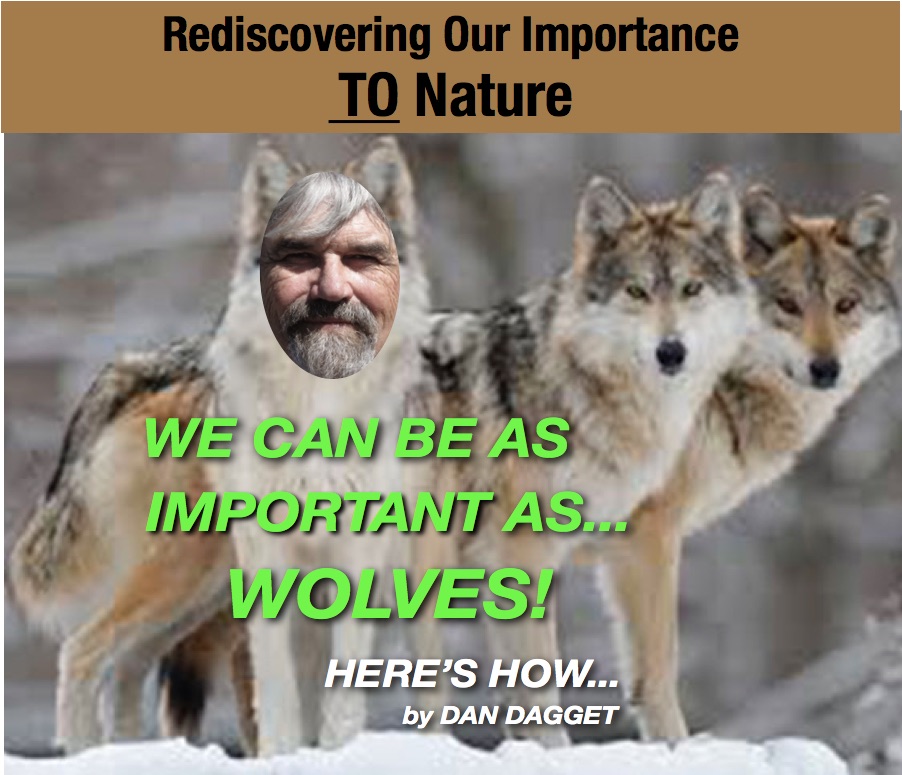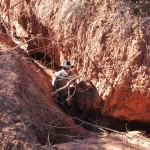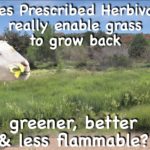
 Recently, I contributed an article to the Summer 2021 Issue of Range Magazine that was inspired by ”WEST FIRST!”, an article in the previous issue of ”Range.” In that article author Dave Skinner wrote that an association of ”billionaires and millionaires” were pouring money, effort, ideas, and influence into a campaign to sell something called the ”rewilding” of the West which, according to Skinner, is intended to remove ranching from much of the West. In his article, Skinner traces the roots of ”rewilding” back to a number of environmental groups — The Wildlands Project/Network, Wild Earth and others, which in turn traced their roots (and the roots of rewilding) back to the self-described ”radical” environmental group Earth First!, which was formed in the 1980s by self-proclaimed eco-radical Dave Foreman.
Recently, I contributed an article to the Summer 2021 Issue of Range Magazine that was inspired by ”WEST FIRST!”, an article in the previous issue of ”Range.” In that article author Dave Skinner wrote that an association of ”billionaires and millionaires” were pouring money, effort, ideas, and influence into a campaign to sell something called the ”rewilding” of the West which, according to Skinner, is intended to remove ranching from much of the West. In his article, Skinner traces the roots of ”rewilding” back to a number of environmental groups — The Wildlands Project/Network, Wild Earth and others, which in turn traced their roots (and the roots of rewilding) back to the self-described ”radical” environmental group Earth First!, which was formed in the 1980s by self-proclaimed eco-radical Dave Foreman.
One of the things I found most interesting in this history lesson and the revelations Skinner derived from it, was that it reminded me that I was personally involved in a number of the events and issues he described. Those reminiscences, I feel, shed additional light on the issues brought to the fore by Skinners article, so here we go.…
First of all, the birth of Earth First!, which could be considered the political launch of the idea of rewilding, happened, at least partially, in the living room of my house in Flagstaff, Arizona. At a meeting of a local Sierra Club group one of the attendees announced that a friend of hers had come up with the idea of forming a radical activist environmental group and was enlisting help to perform its first direct action — symbolically cracking Glen Canyon Dam that formed Lake Powell on the Colorado River. She told us that her friend (Foreman) was looking for volunteers to put together an immense plastic ”crack” that could be unfurled down the face of the dam representing its destruction, the emptying of Lake Powell, and the rewilding of Glen Canyon to the dramatic, unobstructed gorge nature had created it to be. And then she told us where and when we could participate in the making of the crack

I made it to the plastic crack-making get-together but was on the road during the actual unfurling of the “crack” down the face of the dam. During that event environmentalist Edward Abbey, author of the environmentalist classic ”The Monkey Wrench Gang” gave a talk that made local and national headlines. That 60s style demonstration received so much attention that I hurried home to participate in its celebration which happened a few days later on the shores of the lake — the dam now being off-limits. I participated in that celebration/demonstration by carrying a sign and handing out t-shirts along with a number of the original members of Earth First!

The enthusiasm created by that event certainly fueled my activism for some time. After my participation in the cracking of the dam celebration I served as co-coordinator for northern Arizona of the Sierra Club’s ”Adopt a Wilderness” program that helped get the Arizona Wilderness Act of 1984 passed by Congress. In addition, I wrote an article that was published in the national Sierra Club Magazine which dealt with the threat posed by uranium mining in the vicinity of Grand Canyon National Park.n As an Earth First!er I initiated a campaign to limit the open-ended character of predator control programs directed at mountain lions and black bears in Arizona by ranchers and hosted a number of Earth First! gatherings.
As a result of all that I received an ”Environmental Hero” award as one of the top 100 grass roots environmental activists in America by the Sierra Club for its John Muir Centennial celebration, in 1992.
Not too long after those events things began to change dramatically in a surprising way. As I participated in a variety of campaigns to re-wild rangelands by returning them to Nature via wilderness designation, increasing protection for mountain lions and other predators, and removing livestock grazing from public lands, I encountered ranchers who were proud enough of the results their stewardship was achieving that they invited me and others to come and compare the ecological health of their ranches to the results of rewilding on preserves some of which were just across the fence.
On those field trips, many of us enviros (including some Earth First!ers) were suprised to see that, in comparison to the results our rancher hosts were showing us on land they managed, the preserves we visited could more accurately be described as de-wildings rather than re-wildings.
The explanation given for this by our rancher hosts, was that they kept their animals herded and moving in order to ”mimic the behavior of bygone herds of bison, elk, bighorn sheep and more” so that their livestock might have a similar impact to those native herds. In the process, they pointed out, they were mimicking the ecological function of apex predators, the same role played by wolves, mountain lions, grizzly bears, and, not all that long ago, by Native American Lakota, Blackfeet, and others. This interaction, they pointed out, was almost assuredly responsible for the ”natural” health and condition of the Western Great Plains that so surprised Europeans when we first arrived here, and was also responsible for the rangeland health we were seeing today.
Since one of the major components of the dewilding campaign masquerading as a ”rewilding” is the removal of livestock grazing and ranching, even when it replicates the apex predator/herd animal interaction just described, this, in effect, unmasks de-rewilding as a predator control campaign. It also unmasks it as a form of white supremacy because it ”disses” a means of managing and interacting with nature associated with and applied by Native Americans. In fact, some Native American tribes are already objecting to one application of the rewilding: the formation of the American Prairie Reserve in the Northwest on this basis. (link)
Heightening the irony of this, the proponents of the de-rewilding program allege that predator removal is a major cause of the West’s rangelands’ ecological problems, even though the solution they propose is the removal of an important predator-prey relationship — applied by humans and herd animals.
The justification offered for this apparent self-contradiction is the current broadly accepted definition of Nature — Nature is all the “‹animals and “‹plants in the “‹world and all the “‹features, “‹forces, and processes that “‹exist or “‹happen “‹independently of “‹people.” (Source the Cambridge Academic Content Dictionary)
The problem with that is, as a species, we humans trace back about two and a half million years. That’s how long ago science tells us we evolved from an ape-like ancestor, Homo Habilis, by eating significant quantities of meat, which, in turn, caused us to eat less plants. Since digesting plants requires a bigger gut, these meat-eaters developed a more compact digestive system along with a more upright, longer-legged posture and evolved into the erect, mobile, effective predator, Homo Erectus. In addition, the desire, need, and urge to be a more effective hunter and acquire more meat provided the impetus for our intelligence to hit the fast track and continue evolving to our current status as Homo Sapiens (wise man) between 800,000 and 300,000 years ago.
During those millions of years here on planet Earth, before and after we evolved into Homo Erectus, we humans served as a functional part of the ecosystems that formed our habitat. We served as hunting, herding predators, as well as gatherers, planters, harvesters, scavengers, and more. And we performed those functions in the same way a lot of other animals we wouldn’t even think of deeming ”unnatural” did it. We hunted in packs, like wolves, and gathered and planted (buried) wild nuts and berries as squirrels and other animals do.
In view of this, it makes sense to ask: When did we become ”unnatural” to such a degree, and in such a way, that it makes any sense whatsoever to say,”The way to make something natural is to remove humans from it.” As John Muir, the founder of the Sierra Club, put it.
A good answer to that question is: We subjected ourselves to the designation as ”alien” or “unnatural” when we developed agriculture and switched from hunter/herders (like wolves and Blackfeet) to farmers and pasturers and then to factory farmers and feedlot operators. The effectiveness this created has enabled the rest of us to get what we need at the store or on line and live in communities that are as disconnected from Nature as an alien space-station might be. In other words, we subjected ourselves to the self-designation of ”alien” when most of us started acting as such and signed off of our role as hunting, gathering natives.
This brings us back to the dilemma to which ”rewilding” is supposedly the answer: If we live on earth as technologically adept eco-aliens, how can we deal effectively with the environmental problems caused by our doing so?
Actually when it comes to dealing with the population explosion made possible by mega-farming, techno-living, etc., developing an environmentalism based on thinking of ourselves as eco-aliens has some plusses.
Since thinking of ourselves as aliens motivates us to deal with the population growth caused by our agricultural/technological success by becoming even more technologically adept and using less and less land, what this actually does is provide more rewild-able land on which to re-introduce one of the most effective apex predators nature has ever created — Homo Natural (Us).
And since that would restore more and more land to ecological health, sustainability, and natural-ness while making planet Earth more, rather than less, inhabitable ; the real challenge becomes: How to convince those eco-aliens to do a real rewilding instead of a de-wilding?
(It is worth noting here that, since my re-awakening a number of environmental groups are undergoing the same experience. In the Spring 2017 issue of Audubon Magazine, for instance, in an article entitled ”How Cattle Ranchers Are Helping to Save Western Grasslands and Birds,” author Purbita Saha writes: ”The cows themselves are one of the best tools for renewing grasslands.” And then he adds the ”how”… Rotating where they graze mimics the behavior of bygone bison herds…”
Other groups expressing varying degrees of that same awareness (that I noticed) include the Sierra Club — ”Ruminants are a righteous way to reduce fire risks”) and The Nature Conservancy — ”Livestock grazing on intact, working grasslands can help secure clean water, enhance habitat, address climate change and sustain rural communities.”
More irony… Add to all that the group that Skinner said was pouring money, effort, ideas, and influence into a campaign to remove ranching from much of the West — the Western Landowners Alliance. When I visited their website I saw a number of photos and articles that dealt with ranchers and environmentalists working together to restore rangeland health via ranching. One that particularly caught my eye was ”Lord Willing And The Creek Don’t Rise: How We Show Up For Each Other In Community On The Range.” Another dealt with an environmentalist and rancher group I helped form, ”The Diablo Trust.”






Hey Dan, thanks for a great read.
The topic of “when did humans become unnatural” is interesting. I would phrase it differently and say “when began humans to alter environments greatly.” We humans can’t do anything without tools, and fire is one of them and I think it has played an enormous role in our history in terms of degrading environments along with organized hunting. We think everything was natural 500-1000 years ago but then look at Sahara, it used to be green 5-8000 years and was most likely degraded by humans and I believe America, Australia, the Middle East, even Asia was altered greatly as well. https://blog.frontiersin.org/2017/03/14/did-humans-create-the-sahara-desert/
I find Allan (Savory)’s conclusion true that the problem we humans have is how we make decisions, and to truly solve it we need to adopt a new decision making process.